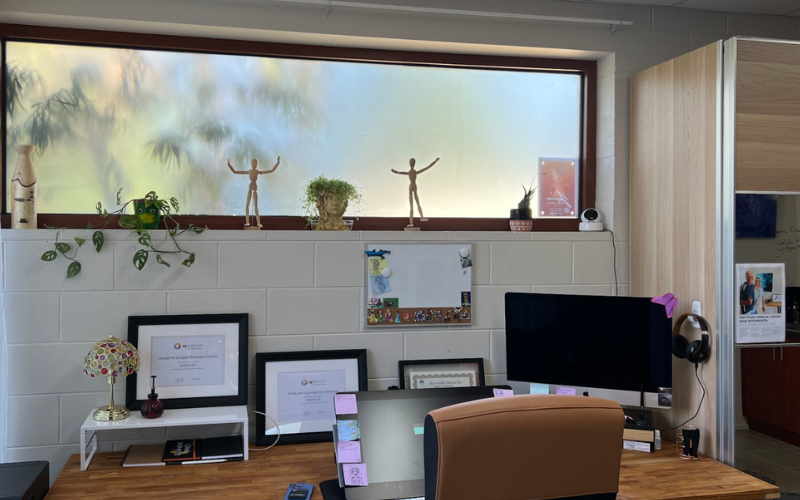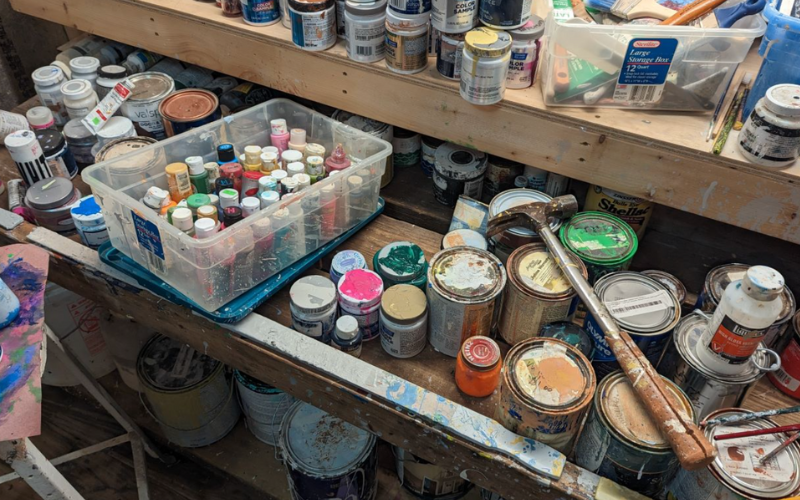
Photo courtesy of Artwork Archive artist Allison Jones Hunt
Social media is great for artists to promote and share their artwork—until it's not.
Artists have more control over their art careers than ever before. Social media has opened up new ways to sell artwork, build an audience, and create opportunities without relying solely on galleries.
But here’s the problem: social media isn’t guaranteed.
We hear it all the time: I think I’m shadowbanned. The algorithm changed, and now my reach is tanking. I got hacked and had to start all over.
And after the recent (albeit brief) TikTok ban, it got us thinking…
What if social media disappeared tomorrow? Would you still be able to reach your collectors, or would your audience vanish overnight?
If the thought of losing your account makes you panic, it’s time to seriously consider building an email list.
Let’s talk about why email lists matter, how to start yours from scratch, and exactly what to send. (Bonus: We’ve included a six-month content plan to make it easy.)

Photo courtesy of Artwork Archive artist Jessie Belle Van Loon
Why Artists Need an Email List to Build Lasting Connections with Collectors
Not convinced you need an email list? Keep reading.
You Own Your Audience—Kind Of.
PSA: you don't own your Instagram followers. If social media is the only way you connect with your audience, you're basically renting space in someone else's house. And the landlord (aka Meta) can change the rules—or shut the doors—whenever they want.
But an email list? That's your house. You own the keys (in this case direct access to your audience). When someone subscribes, they’re giving you permission to reach them—no algorithm standing in the way.
Email is Personal—And Reaches the Right Buyers for Your Artwork
When you send an email, you’re speaking directly to your audience—no competing posts, no ads, no distractions. Think about it: when was the last time you saw a post on Instagram from someone you actually follow? Better yet, scroll through your feed right now. Sure, you'll find a few—but most of it is suggested content and paid ads.
A collector is far more likely to read your newsletter than stumble upon your post in an algorithm-driven feed.
Email Gives Artists More Control.
You decide when and how often you connect with your audience. Again, when you send an email, you're not waiting for an algorithm to favor your post. If you have an important show coming up, you can gurantee your subscribers see it instead of rolling the dice with social media reach.
Your Art Collectors Check Their Email.
Before you think, “But I hate emails” or “Who even checks email anymore?"—your collectors do. And they buy from them.
In fact, studies show that email is still one of the highest-performing marketing channels out there, delivering serious results. For every $1 spent on email marketing, businesses see an average return of $36. That’s a hard number to ignore.
So, no… technically, you don’t need an email list—just like a painter doesn’t technically need a paintbrush. But it sure makes things a whole lot easier.
Photo courtesy of Artwork Archive artist Greg Hausler
How Artists Can Build an Email List from Scratch to Grow Their Art Business
Building an email list might sound intimidating, but it’s actually pretty simple—and you don't have to reinvent the wheel.
The key is to make it easy for people to sign up and give them a reason to do so. Here’s how:
Step 1: Choose Your Email Platform and Set Up Your Welcome Sequence
Before you start collecting emails, you need a place to store them and send newsletters from. Here are a few artist-friendly email marketing tools:
Mailchimp – Great for beginners with easy drag-and-drop templates.
Flodesk – Beautiful designs and a simple interface.
Kit – Best for creators who want more automation.
Once you pick a platform (most of these offer free trials), set up a welcome email that new subscribers will automatically receive when they sign up. This is where you re-introduce yourself, tell them what they can expect from your emails, and thank them for subscribing.
Step 2: Make it Easy for Interested Art Buyers to Sign Up
If you want people to join your email list, you've got to make it effortless.
- Website: Add a sign-up form or a pop-up where visitors naturally browse.
- Artwork Archive Public Profile: Include your signup link in your About page.
- Instagram: Your bio is prime real estate—use a link-in-bio service to feature your signup form.
- In-Person Events: Art fairs, markets, and open studios are perfect opportunities to collect emails. Have a sign-up sheet or a even a QR code on your business card!
Step 3: Offer Exclusive Benefits That Turn Email Subscribers Into VIP Collectors
No one signs up for an email list just for the joy of getting more emails. If you want people to subscribe (and stay subscribed), you've got to give them a reason.
Think of your email list as an insider’s club—your subscribers should feel like they’re getting something special that they can’t get anywhere else. Here are some ideas of what you can offer:
- First dibs on new work. Before you announce a collection on Instagram or your website, let your email subscribers get early access (and maybe a smaill discount). A little exclusivity goes a long way.
- **Behind-the-scenes content* *But different from what you already share on social media. While Instagram might get quick snapshots or a timelapse of a WIP, your email subscribers could see deeper, more personal updates. Share the full story behind a piece, the creative struggles you faced, or a peek at sketches and raw ideas that never make it to social.
- Private sales before anyone else. Reward your email list with VIP treatment. Whether it’s an exclusive pre-sale, a discount, or access to limited-edition pieces, make sure they feel like they’re getting something special.
- Exclusive previews through Artwork Archive’s Private Rooms. Want to gauge interest before a piece goes public? Show select collectors your new work in a private, invite-only digital space.
What are Private Rooms on Artwork Archive—and how can you use them in your emails??
Private Rooms on Artwork Archive are invite-only online viewing rooms where you can share curated selections of your artwork with collectors, galleries, or buyers.
Enable comments and "likes", update availability in real time, and include purchase inquiry options to keep the sales process seamless and exclusive. Perfect for pre-sales, VIP previews, or custom portfolios.
Step 4: Schedule Regular, Valuable Communications Through a Simple Email Strategy
Now that you're getting subsribers, what do you actually send them—and how often? Start with once or twice a month. Enough to stay top of mind, but not enough to be annoying.
Batch your emails. Just like you batch your artwork or social media content, set aside time to draft the next month’s emails (that’s just one or two). Maybe it takes a morning, or maybe you save it for a slower creative day. Either way, you don’t want to be scrambling last minute to send out a rushed email full of typos and low-value content.
And if you feel like you have nothing to share? That's okay—skip an email! Then, when your'e ready, this them with "Did you miss me?" There are no strict rules when it comes to your email list. This is your chance to connect authentically with your audience. Say what feels right and share what excites you—your fans will love you for it.
Here's a simple plan with sample email starters to get you thinking:
-
Behind-the-Scenes Process: Subject: "Ever wonder what a working artist's studio reallly looks like?"
"Hey [First Name], today I’m letting you in on a little secret: my studio is a glorious mess. But that’s where the magic happens! I’ve been working on something new, and I wanted you to get a first look before I clean up (or don’t). Check it out here: [insert link]."
-
Collector Spotlights: Subject: "Meet the collector who fell in love with this piece."
"I always love hearing the stories behind why collectors choose my work. Recently, [Collector's Name] shared why this piece spoke to them—and it’s a good one. If you’ve ever wondered what makes art connect on a deep level, this is a must-read: [insert link]."
-
Audience Participation: Subject: "Help me name my latest piece!"
"I’m stuck. I just finished a new piece, and I have no idea what to call it. HELP!!! Drop your best title ideas by replying to this email, and you might just give me the inspiration I need. (Bonus: whoever helps me gets a surprise gift!)"
-
Studio Updates: Subject: "What’s coming next (and how you can get first dibs)"
"Big things are happening in the studio! I’m gearing up for a new release, and I want you to be the first to know what’s coming. Here’s a sneak peek of what I’ve been working on: [insert Private Room link]."
-
Exclusive Offers: Subject: "Early access just for you!"
"Because you’re on my email list, you get special perks. My latest collection drops next week, but you get first dibs before it’s available to the public. Click here to browse before everyone else: [insert Private Room link]."
A Bonus Gift From Us to You: The First Six Months of Your Newsletter (Content Plan):
Why Now is the Time to Start Your Email List to Grow Your Art Business
If you take one thing away from this guide, let it be this: social media is borrowed space, but your email list is yours.
Platforms change. Accounts get hacked. Algorithms shift. And an email list gives you something no platform can—direct, reliable access to the people who care about your work.
So start now! Even if you have zero subscribers. Even if you feel like, “I don’t know what to write.” Even if you’re convinced no one will sign up. Start anyway. Because every big list started with one person.






